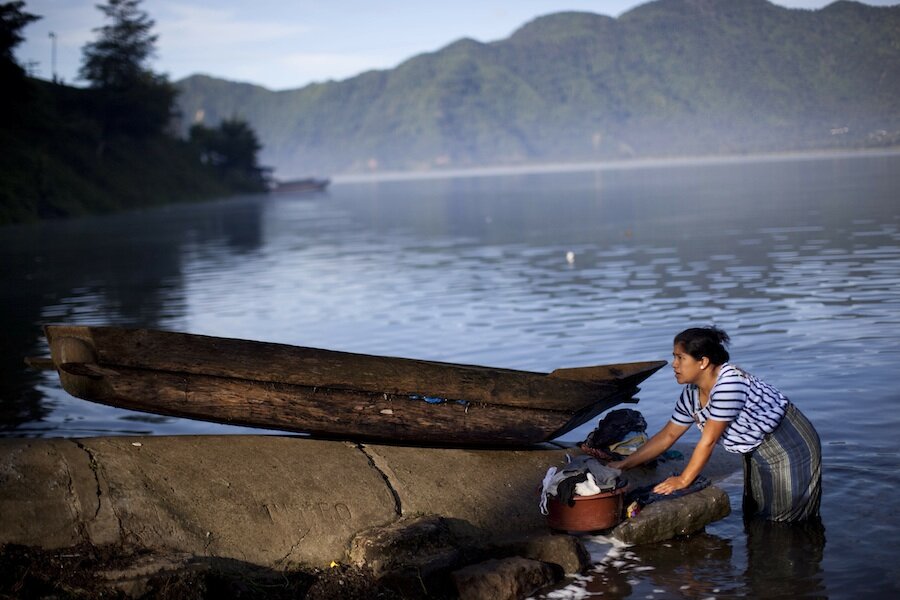Can Guatemala revive Lake Atitlán before it's choked by trash?
Loading...
| PANAJACHEL, GUATEMALA
It's a windy afternoon and Lake Atitlán is choppy. Laden with 14 passengers, the last ferry of the day is about halfway across the lake when the captain abruptly cuts the engine.
"Demasiada basura," he says. Too much trash. The boat is encircled by floating plastic bottles and other household garbage that threatens to gum up the motor. The boat is moving again soon enough, but just a few minutes later the captain stops again to clear debris.
"People don't get it," he says, shaking his head.
Ringed by verdant volcanoes and enchanting little villages, Lake Atitlán has been called the most beautiful lake in the world and is one of Guatemala's top tourist attractions. But the lake is slowly dying because of the thousands of tons of trash, fertilizer, and raw sewage dumped into its now-murky waters each year. At stake is not only the area’s dominant tourism industry, but also the livelihood of its small-scale fishermen and the fate of some 100,000 indigenous Guatemalans who rely on the lake for drinking water.
“The lake is in a very precarious state,” says Sudeep Chandra, an associate professor of ecology at the University of Nevada, Reno, and the project director for United for Lake Atitlán, an international research partnership that recently released its 2013 State of the Lake report.
Atitlán is Central America’s deepest lake, and is surrounded by 15 communities made up of around 350,000 people. Yet only a few inefficient sewage treatment plants serve the area. That has led to dangerous algae blooms, including toxic cyanobacteria, which prompted the Global Nature Fund to designate Atitlán its “Threatened Lake of the Year” in 2009. Since then, despite widespread media coverage and the announcement of an ambitious government plan to clean up the lake, the report found “no apparent improvement in wastewater management around the lake."
But recent collaborations between local researchers and scientists abroad who have dealt with similar challenges in the past are offering a glimmer of hope for Lake Atitlán’s future.
“It’s just one of many lakes in developing countries that are facing the same problems that developed countries faced 40 years ago,” says Mr. Chandra, whose USAID-funded investigation paired up Guatemalan researchers with those who work on Lake Tahoe, in the US's Sierra Nevada. “Whether China or Honduras or Guatemala, they’re putting sewage directly into their lakes, and that is what’s causing these problems.”
Just 3 to 5 percent of wastewater in Latin America is treated at all, according to the report. Existing wastewater treatment plants at Lake Atitlán do not remove the phosphorus on which polluting bacteria feeds, nor pathogens like E.coli and giardia that threaten human health.
The only viable solution for Atitlán, in the researchers’ view, is to do what Lake Tahoe did in the 1970s: Export wastewater out of the basin to be converted for agricultural use, rather than build more treatment plants at the lake.
Lakes in Italy, Germany, Russia, and elsewhere have also adopted this approach. An Italian delegation recently came to Guatemala to share its experiences cleaning up Lake Como. Here, however, drumming up political support for protecting the lake is an added challenge. A grant from the Spanish government, for example, had been in limbo for years due to a lack of complementary funding from Guatemalan authorities.
“For the Italians it was easier, because they have [more] homogeneous [communities], but this is a very culturally complex region,” says Monica Orozco, whose Center for Atitlán Studies at the Universidad del Valle was a partner in the Italian visit. She’s referring to Guatemala’s diverse mix of Western and indigenous languages, customs, and cultures.
“It’s not easy to make changes in attitudes,” Ms. Orozco says.
Near the dock at Panajachel, the menu at a charming but empty lakeside restaurant promises grilled lake fish to go along with its stunning volcano views. Though the trash floating around the shore below and the faint smell of sewage don't inspire much confidence, there’s some indication the wheels of change are finally starting to turn. A new master plan for the lake is expected this summer from the Lake Atitlán Sustainable Management Authority (AMSCLAE), which is considering the recommendation offered by Chandra’s team, among other options.
“The scientific information is very clear,” says Ivan Azurdia, executive director of AMSCLAE. “But it’s part of the negotiation. There are many interests and opinions involved."
“There is still a strong possibility to conserve Lake Atitlán and make it beautiful again,” says Chandra. “But unless the government and local people act quickly, it will become very similar to other lakes of the world [whose decline] is almost impossible to reverse.”







